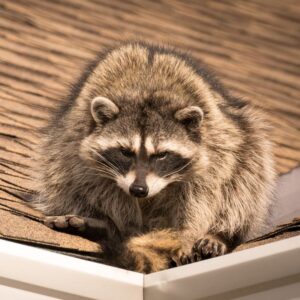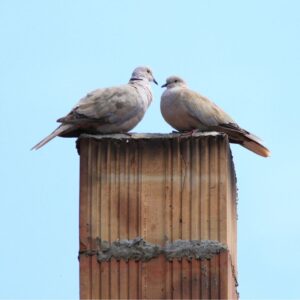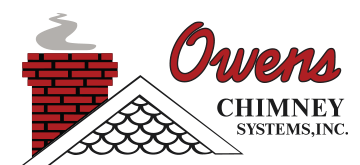Fireplaces, furnaces, and wood stoves keep us nice and cozy on colder days, but if you settle in for the evening and hear scurrying or chirping, it’s possible something else has found a cozy spot on the chimney side of things.
Animals find their way into chimneys for various reasons. They may be seeking shelter, attempting to build nests, escaping predators, or searching for food sources. Common culprits include birds, raccoons, squirrels, and bats. Open chimney flues can seem alluring with their promise of warmth and protection. Unfortunately, a chimney can also become a trap for animals who find their way in.
…and while the idea of furry or feathered visitors may be charming in Disney movies, in real life there are many potential dangers associated with sharing your living space with wild animals.
What Are the Dangers of Animals in Your Flue?
 There are lots of reasons you don’t want animals in your chimney flue, ranging from inconveniences to serious hazards.
There are lots of reasons you don’t want animals in your chimney flue, ranging from inconveniences to serious hazards.
- Annoyances & Odors: The scratching, scurrying, and chirping noises can continue day or night and may be disruptive. The smells associated with animals and their droppings are also intrusive. And, sadly, not all animals are adept at navigating the space of your chimney – in other words, often four-legged visitors get stuck and pass away, amplifying the odor issue and attracting pests and insects.
- Diseases & Injuries: Animals can also carry diseases and parasites, and accumulated droppings, feathers, and nesting material can pose health hazards. In addition, if the critters manage to find an exit through the fireplace into your living space, they may become aggressive or destructive.
- Flue Blockages: Another risk is that of blockages. Animals, and the things they bring into your chimney (and leave behind), can stop the chimney flue from performing its most important job: channeling smoke and gases out of your living space and releasing them outside. If your chimney is obstructed, smoke or carbon monoxide can build up in your home instead of being vented out of it. Accumulated materials can also put you at increased risk of chimney fires.
- Structural Damage: Additionally, trapped animals can cause structural damage to your chimney as they try to nest or escape. While it doesn’t seem like a little critter could do much damage to sturdy construction material, it is possible – especially when the animal feels panicked. Gnawing, scratching, and nesting can chip bricks, dislodge mortar, or damage chimney liners, necessitating costly repairs.
We Prioritize Humane Removal
Since it’s apparent that hosting animal lodgers isn’t ideal for you – or for them in most cases, for that matter – humane removal should be prioritized. If you find yourself faced with the predicament of animals in your chimney, help is a phone call away. We’ll take care of you with human animal removal services. We possess knowledge of chimney systems, tools, and techniques to help safely and compassionately extract animals.
After your guests have been evicted, be sure to schedule a chimney sweeping and inspection. Having your chimney swept will clear out nests, droppings, and debris, which is vital to continuing the safe and efficient use of your fireplace and chimney.
After Removal: Keeping Your Chimney Animal-Free
 The next challenge lies preventing animals from re-entering your chimney after removal. We can help by inspecting your chimney every year before the burn season begins, and by taking additional protective measures such as installing a chimney cap or top-sealing damper.
The next challenge lies preventing animals from re-entering your chimney after removal. We can help by inspecting your chimney every year before the burn season begins, and by taking additional protective measures such as installing a chimney cap or top-sealing damper.
If an animal is finding their way in, it’s likely that your chimney cap is missing or damaged. Having your professional identify and install a well-fitting chimney cap with proper screening will be immensely helpful in blocking animals from entering your chimney while still letting gases and smoke escape.
As a bonus, it’ll also keep out other debris and protect your chimney system from the adverse effects of precipitation – making it an all-around excellent investment in the maintenance and lifespan of your chimney. Another helpful measure can be upgrading to a top-sealing damper, which will also prevent animals from gaining entry to your chimney as well as reduce energy cost when the system is not being used.
A Special Case: The Chimney Swift
While removing animals quickly and humanely is important, some animals can’t be immediately moved. Chimney swifts are small migratory birds that roost and nest on vertical surfaces. Because their population is declining, these birds are federally protected. Chimney swifts like to nest in chimneys during their breeding season, and they can’t be removed until after their fledglings have left the nest.
And after they’ve left? It’s the perfect time to install a chimney cap.
Count On Owens Chimney
The presence of animals in chimneys can be problematic, but we’re a call away to help you with animal removal and chimney care. With a proper response, we can not only remedy your infestation problem, but also take leaps toward preventing it from occurring again – and avoid costly repairs or health hazards.
Remember, the best thing you can do for your chimney is schedule annual inspections. In your inspection, signs of animals can be addressed before issues are aggravated, and your chimney technician can try to find and seal points of entry for critters. Let us know if we can help meet your chimney care needs! Reach out online or call today.
